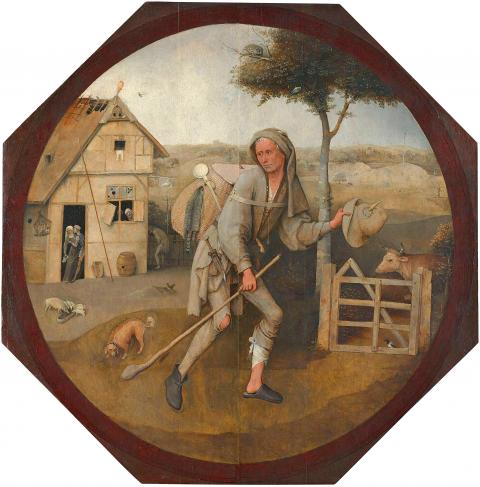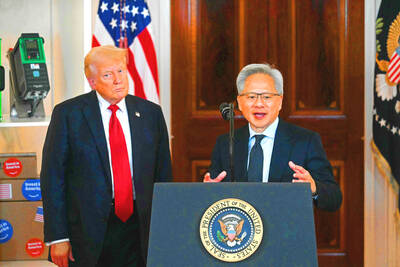Chinese Practice
有目共睹
(you3 mu4 gong4 du3)

Photo: Wikimedia Commons
照片:維基共享資源
As everyone with eyes can see
水是冷的,火是熱的,金屬和石頭都是硬的──這些是大家都知道的,並不需要再詳述其屬性──東漢末文學家徐幹在其政論《中論》中如此寫道。他的觀點是,人們把自己長期以來所觀察到的一貫性視為真實。然後他引孔子的話說,「欲人之信己也,則微言而篤行之」(如果你希望別人相信你,你應該要少說嘴,多做事,讓行動來說明一切)。徐幹繼續寫道,如果你這樣做,「則有目者莫不見也」(有眼睛的沒有看不出來的)。這也就是成語「有目共睹」的由來,其字面意思是每個有眼睛的人都看得到。
這成語的文字更直接地來自元朝李翀的《日聞錄》,其中一句寫道:「日月東出而西沒,有目者所共睹」(太陽和月亮都是由東邊升起,在西邊落下,這是有眼睛的人都看得出來的。)
在英語中也有類似說法「anyone with eyes in their head can see that…」(任何有眼睛的人都可以看見...)另外還有一個講法是表示某事物很清楚明顯,可以說它「as plain as the nose on your face」(就像你臉上的鼻子一樣清楚明瞭)。
這句話是源自十六世紀英格蘭的說法「as plain as a pikestaff」。pikestaff 是過去小販用來搬運用具的矛桿。小販持著矛桿,使得其身影從遠處就可以辨認得出來。後世隨著這樣的小販變得越來越少見,pikestaff這個字就被改成packstaff──這是一種拐杖;再後來packstaff這個字又漸不使用了,所以又改成 the nose on your face。
(台北時報編譯林俐凱譯)
我國在半導體產業上的發展是有目共睹的。
(Everyone knows how developed Taiwan’s semiconductor industry has become.)
陳老師多年來栽培的學生在各行各業都有優秀表現。她對教育的貢獻有目共睹。
(For many years now, Ms Chen’s students have found outstanding success in many fields. Her contribution to education is there for all to see.)
英文練習
anyone with eyes in their head can see that…
as plain as the nose on your face
Water is cool; fire is hot; metal and stone are hard. Everyone knows this to be the case, without the need for these properties to be explicitly stated. So wrote the late Han Dynasty scholar Xu Gan in his political treatise zhong lun, the Balanced Discourses or Discussions on the Mean Way (where “mean” is used in the sense of “average” or “non-extreme”). His point was that people trust what they observe to be consistently true over an extended period of time. He then quotes Confucius as saying 欲人之信己也,則微言而篤行之: “If you want others to trust you, you should allow your actions to speak for you (or, speak sparsely; just act). If you do this, writes Xu, 則有目者莫不見也: "there is nobody with eyes in their head that cannot see this [to be true].” From this we get the idiom 有目共睹: literally, “everyone with eyes can see.”
That formulation more directly derives from a Yuan Dynasty text — the riwenlu (Records of Daily News) — by Li Chong, who writes 日月東出而西沒,有目者所共睹: “The sun and the moon rise in the east and set in the west, as everyone with eyes can see.”
In English, we also say “anyone with eyes in their head can see that….” There is another expression, however, to say that something is very clear or obvious: It is “as plain as the nose on your face.”
The original version of this expression, dating to 16th century England, was “as plain as a pikestaff.” A pikestaff was a stick peddlers used to carry their wares with, the sight of which would have made their identity apparent even from a distance. As peddlers became less common, “pikestaff” was changed to “packstaff” — a walking stick — and later to “the nose on your face” as the word “packstaff” itself fell into disuse.
(Paul Cooper, Taipei Times)
Anyone with eyes in their head can see that he’s in love with her.
(任何人只要長了眼睛,都可以看得出他戀著她。)
That would be a huge mistake. It’s as plain as the nose on your face.
(這真是大錯特錯。這是顯而易見的。)

Long before numerals and arithmetic systems developed, humans relied on tally marks to count. These simple, repeated marks — often just straight lines — are one of the earliest and most widespread methods of recording numbers. Archaeological findings suggest that humans began tallying in prehistoric times. During the Late Stone Age in Africa, humans began to carve notches onto bones to create tangible records of quantities. One of the earliest known examples is the Wolf bone, an artifact unearthed in Central Europe in 1937. This bone bears notches believed to be an early form of counting. Even more intriguing

A: In addition to Teng Kai-wei, Taiwanese infielder Cheng Tsung-che was called up temporarily to play for the Pittsburgh Pirates in early April. B: Yeah, Cheng is the 18th player in Taiwan’s baseball history to be moved up to the majors. A: Back in 2002, Chen Chin-feng became the first Taiwanese to play in the Major League Baseball (MLB), followed by Tsao Chin-hui, Wang Chien-ming, Kuo Hung-chih, Hu Chin-lung and Lin Che-hsuan. B: Those pioneers were later joined by Lo Chia-jen, C.C. Lee, Ni Fu-te, Chen Wei-yin, Wang Wei-chung, Hu Chih-wei, Tseng Jen-ho, Lin Tzu-wei, Huang Wei-chieh, Yu Chang,

When Nvidia CEO Jensen Huang revealed on Friday last week that the company is working with the Trump administration on a new computer chip designed for sale to China, it marked the latest chapter in a long-running debate over how the US should compete with China’s technological ambitions. The reasoning has sometimes changed — with US officials citing national security, human rights or purely economic competition — but the tool has been the same: export controls, or the threat of them. Nvidia believes it can eventually reap US$50 billion from artificial intelligence (AI) chip sales in China. But it so far has

Continued from yesterday(延續自昨日) https://www.taipeitimes.com/News/lang In many Western countries, the most common form of tally marks employs a five-bar gate structure: four vertical lines followed by a diagonal slash. To form this group, one begins by drawing four parallel vertical lines, each representing one. For the fifth, draw a diagonal line across the existing four. This diagonal stroke effectively creates a distinct group of five. To continue counting, just initiate a new cycle in the same manner. A set of five tallies combined with a single vertical line next to it represents the number six. Across many Asian countries, the Chinese character